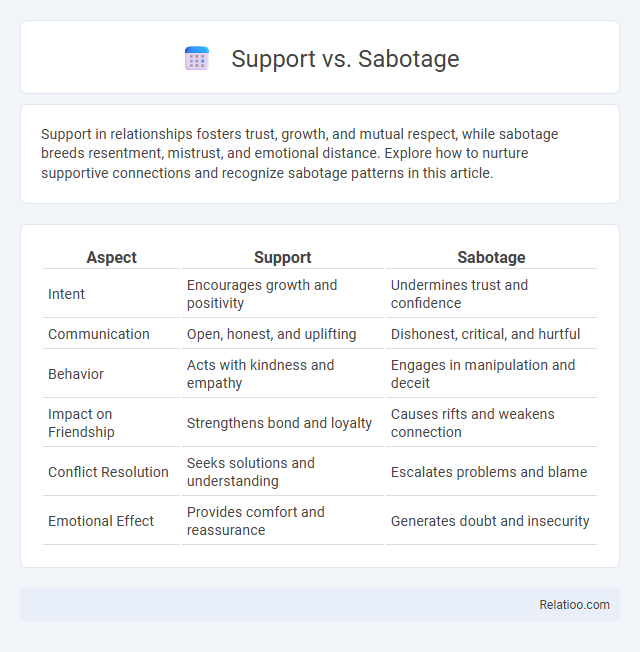Support in relationships fosters trust, growth, and mutual respect, while sabotage breeds resentment, mistrust, and emotional distance. Explore how to nurture supportive connections and recognize sabotage patterns in this article.
Table of Comparison
| Aspect | Support | Sabotage |
|---|---|---|
| Intent | Encourages growth and positivity | Undermines trust and confidence |
| Communication | Open, honest, and uplifting | Dishonest, critical, and hurtful |
| Behavior | Acts with kindness and empathy | Engages in manipulation and deceit |
| Impact on Friendship | Strengthens bond and loyalty | Causes rifts and weakens connection |
| Conflict Resolution | Seeks solutions and understanding | Escalates problems and blame |
| Emotional Effect | Provides comfort and reassurance | Generates doubt and insecurity |
Understanding Support and Sabotage
Understanding support involves recognizing actions and behaviors that encourage growth, facilitate problem-solving, and boost morale within a team or organization. Sabotage, on the other hand, consists of covert or overt actions that undermine efforts, disrupt progress, and create internal conflict, often jeopardizing collective goals. Your ability to distinguish between genuine support and subtle sabotage is crucial for fostering a healthy environment conducive to transformation.
Key Differences Between Support and Sabotage
Support involves actions that promote growth, collaboration, and positive outcomes by providing resources, encouragement, and constructive feedback. Sabotage, in contrast, entails deliberate efforts to undermine, obstruct, or damage processes, relationships, or goals, often motivated by hidden agendas or conflicts. Key differences include intent, with support fostering trust and progress, while sabotage erodes confidence and threatens stability.
Recognizing Supportive Behaviors
Recognizing supportive behaviors involves identifying actions such as active listening, providing constructive feedback, and fostering collaboration, which enhance team cohesion and productivity. These behaviors contrast sharply with sabotage tactics like undermining efforts, spreading misinformation, or creating conflict, which erode trust and stall progress. Emphasizing supportive interactions drives transformation by encouraging positive change and innovation within organizations.
Identifying Signs of Sabotage
Identifying signs of sabotage involves recognizing deliberate actions that undermine progress or harm your goals, such as spreading misinformation, obstructing workflows, or fostering distrust among team members. Sabotage often disguises itself through subtle behaviors like missed deadlines, unexplained errors, or passive resistance that disrupts collaboration. You should remain vigilant in monitoring these indicators to protect your projects from hidden threats and ensure a constructive environment for transformation and support.
The Impact of Support on Success
Support plays a critical role in achieving success by fostering collaboration, enhancing motivation, and providing resources necessary for growth. Empirical studies demonstrate that organizations with strong support systems experience higher productivity and employee satisfaction, directly correlating with successful outcomes. In contrast, lack of support often leads to sabotage behaviors, hindering transformation efforts and reducing overall effectiveness.
The Damaging Effects of Sabotage
Sabotage undermines team cohesion and erodes trust, leading to decreased morale and productivity in the workplace. Your efforts to foster collaboration can be derailed by covert actions that disrupt communication and create conflicts. Recognizing and addressing sabotage early is essential to prevent long-term damage and enable genuine transformation and support to thrive.
Strategies to Foster Genuine Support
Strategies to foster genuine support involve creating transparent communication channels, setting clear goals, and actively engaging team members to build trust and collaboration. Empowering individuals with resources and recognizing their contributions enhances motivation and reduces the likelihood of sabotage. Your organization's transformation thrives when support is cultivated through inclusive leadership and consistent feedback loops.
How to Address and Prevent Sabotage
Recognizing sabotage involves identifying behaviors that undermine team goals, such as misinformation or intentional delays. You can prevent sabotage by fostering open communication, setting clear expectations, and promoting a culture of accountability and trust. Implementing regular feedback mechanisms and conflict resolution strategies helps address issues early, ensuring a supportive environment that encourages transformation instead of disruption.
Building a Culture of Support
Building a culture of support enhances collaboration, boosts employee morale, and drives organizational success by fostering trust and open communication. Emphasizing support over sabotage minimizes internal conflicts and creates an environment where innovation and transformation can thrive. Implementing recognition programs and encouraging teamwork are key strategies to sustain a supportive workplace culture.
Transforming Sabotage into Constructive Action
Transforming sabotage into constructive action involves identifying underlying issues such as miscommunication or lack of trust that fuel counterproductive behaviors. Implementing transparent feedback mechanisms and fostering collaboration channels empowers team members to redirect negative impulses into innovative problem-solving. Encouraging accountability and recognizing small achievements cultivates a culture where sabotage is replaced by proactive support and meaningful transformation.

Infographic: Support vs Sabotage
 relatioo.com
relatioo.com